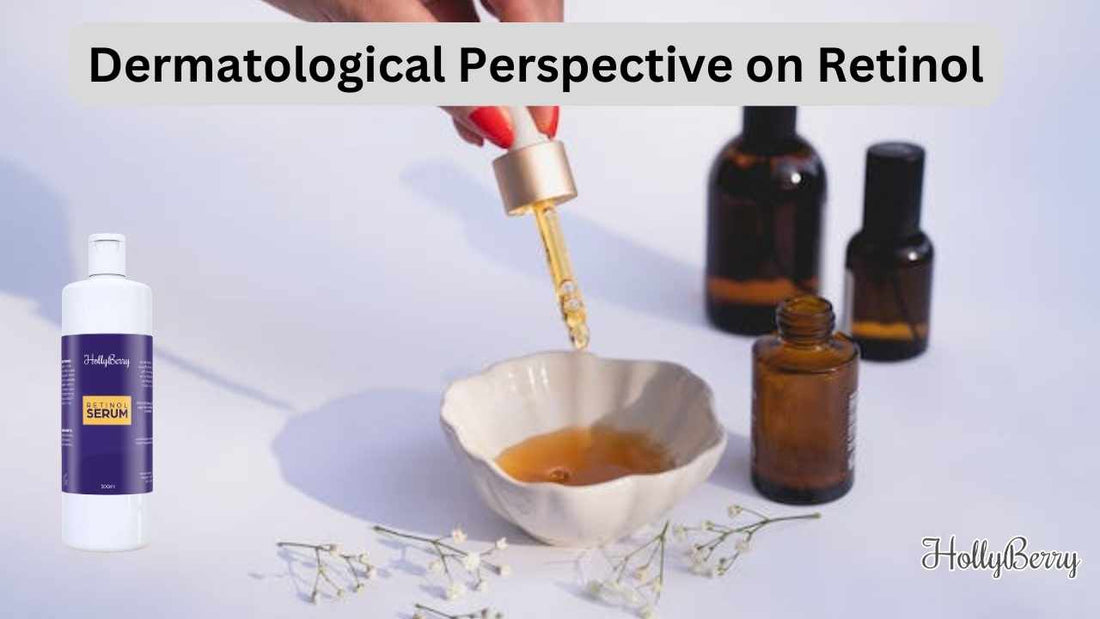
Dermatological Perspective on Retinol
Share
Insights on Its Efficacy and Use

Retinol, or Vitamin A1, has long been a cornerstone of dermatological treatments due to its profound effects on the skin. In the realm of dermatology, retinol and its derivatives—collectively known as retinoids—are recognised for regulating keratinocyte proliferation and promoting collagen synthesis.
They serve as effective treatments for various skin concerns, addressing issues from photoageing and acne to more complex conditions such as psoriasis and keratosis pilaris.
The efficacy of retinol in dermatology is underpinned by its mechanism of action, involving the modulation of gene expression that influences cellular differentiation and proliferation.
Retinol's journey from a simple vitamin to a staple in dermatological therapy involved understanding its metabolism within the skin, where it is converted to its biologically active form, retinoic acid. This metabolic pathway is central to retinol's function, as it allows for targeted interventions within various layers of the epidermis.
Adhering to the correct usage guidelines is crucial for harnessing the benefits of retinol while mitigating potential side effects. Dermatologists emphasise the importance of considering retinoid teratogenicity, particularly in treatments involving women of childbearing age.
With science continually evolving, new derivatives like trifarotene are being reviewed, offering fresh perspectives and improved solutions in the treatment of dermatological conditions.
Retinol and Its Dermatological Benefits
Retinol, a derivative of Vitamin A, has long been hailed for its significant contributions to skin health, particularly in anti-ageing and acne treatment.
Understanding Retinol and Retinoids
Retinol, along with other retinoids, is a potent derivative of Vitamin A, pivotal for numerous skin functions.
These compounds are essential for the maintenance and repair of skin tissue. Retinol itself is a less potent form compared to retinoic acid but is commonly used in over-the-counter skincare products due to its gentle nature.
Role in Skin Aging and Anti-Ageing Effects
Retinol stands out for its anti-ageing effects, largely attributed to its ability to promote cell turnover and collagen production.
These processes are crucial in mitigating the signs of skin ageing. Studies indicate that retinol and its more potent form, retinoic acid, can visibly reduce wrinkles and improve skin texture, substantiating their role as powerful antioxidants against skin ageing.
- Major benefits include:
- Reduction in the appearance of fine lines
- Enhanced skin firmness
- Improved skin texture and tone

Retinol serum 500ml on sale now
Retinol in Acne and Pigmentation Treatment
In the realm of acne management, retinol has been a cornerstone treatment, primarily due to its ability to unclog pores and reduce breakouts. For hyperpigmentation, retinol aids in the skin's natural exfoliation process to diminish dark spots and even out skin tone.
- Key actions of retinol in acne and pigmentation treatment:
- Exfoliation of dead skin cells
- Regulation of oil production
- Promotion of an even skin tone
Clinical Application and Considerations
Retinoids have revolutionised dermatological treatments, with a wide range of formulations available for clinical use.
These formulations cater to varying skin types and conditions, necessitating an understanding of their proper applications and potential side effects for optimal patient outcomes.
Formulations and Topical Applications
Retinoids are available in numerous formulations and strengths, each suited for specific dermatological needs.
Topical retinoic acid, for instance, is used extensively for acne management due to its ability to modulate cell apoptosis and promote wound healing.
On the market, one can find over-the-counter products with retinol or retinyl palmitate, which are less potent than prescription formulas but can still contribute to skin rejuvenation and collagen production.
Prescription retinoids, such as tazarotene and adapalene, are tailored for more severe conditions and are known for their efficacy in topical applications. When discussing topical retinoids, it's important to consider the vehicle of formulation—gels, creams, or lotions—which determines the penetration and, consequently, the effect on the skin.
Potential Adverse Effects and Management
Skin irritation, encompassing dryness, peeling, erythema, and pruritus, is a well-known side effect of retinoid therapy, often referred to as 'retinoid dermatitis.' To manage these adverse effects, it's advised to start with a lower concentration and gradually increase the frequency of application as tolerance develops. Strategies to mitigate irritation include:
- Moisturisers: Applying non-comedogenic moisturisers to hydrate the skin.
- Slow Introduction: Gradually introducing retinoids into the skincare routine.
- Buffering: Mixing the retinoid with a moisturiser to reduce its potency.
It is also essential for patients to avoid concomitant use of other potentially irritating topical agents, such as astringents or keratolytic agents, without professional guidance.
